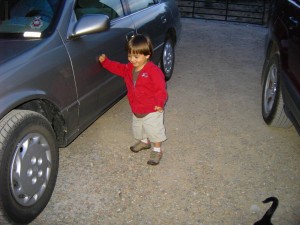Kids and Hot Cars, a Deadly Combination
Sometimes the news just breaks my heart. Just the other day another child died, locked in a hot car.
It reminds me of a close call we had when our younger son was about four. My husband had hopped in the station wagon to run some errands and didn’t notice that our little guy had hidden in the back – the way back, we called it. A lively kid with an active mind, he probably thought it would be fun to surprise Dad.
After the twenty-minute drive to town, my husband pulled into a hardware store and went shopping. Twenty minutes later he came out and set some merchandise on the back seat. That’s when he saw his little boy, looking up at him with this huge grin on his face.
My husband freaked out. He lit into the little stowaway and ordered him to the front seat. Then he turned around and drove home.
The whole time I thought my husband had taken our son along without telling me. A little out of the ordinary, but I didn’t worry. Cell phones had not yet become popular, so calling was out of the question. The ending could have been tragic.
Even today, the incident makes my husband’s heart pound. “What if I’d been gone for hours? What if the car had been hotter?”
We were unbelievably lucky that my husband saw the little rapscallion when he did. It happened in the summer, and even though the weather had been mild, it doesn’t take long for heatstroke to occur.
Inside a car the temperature can rise 19 degrees in ten minutes, said Sally Duncan, Trauma and Injury Prevention Specialist for Memorial Hospital in Colorado Springs and coordinator of Safe Kids-Colorado Springs. “In an hour it can increase by 45 degrees. You can have heat stroke pretty quick.”
Heat stroke occurs at 104 and body temperature is fatal at 107, Duncan said.
A hot car is even hotter for kids. Children’s temperatures rise 3-5 times faster than adults’ because they don’t sweat to reduce body temperature, Duncan said.
“I can understand how it can happen,” said Rita Wiley, co-director of the Family Nurturing Center. “People are too overscheduled. Kids get put on the back burner, relegated, and are not on top of (parents’) priorities.”
It’s easier to remember a child when you can see them, but most states require infants under the age of one year or less than 20 pounds to be placed in the back seat, rear-facing position – out of the parent’s view. While not mandatory, car seats are never recommended in the front whenever a passenger-side airbag is present.
Duncan said parents and care-givers need “a heightened level of concern for their children. With most parents it’s about miscommunication.” In many cases one parent thinks the other has the child.
“It happens more often than we hear about,” said Maile Gray, executive director of Drive Smart Colorado and certified Child Passenger Safety Technician. “Humans are so busy these days. If the baby goes to sleep and is quiet, they just forget.”
Gray suggests leaving a toy or stuffed animal in the front seat of the car as a reminder that a baby is on board. Some parents put a purse or briefcase on the back seat; something that they have to pick up.
Only fifteen states have laws prohibiting leaving a child unattended in a vehicle. I just wonder if those laws made a difference in 2010. According to www.safekidsorg, 49 children died as a result of being left or trapped in hot cars – the highest number on record.
Accidents happen. I know, we almost had one. But there are things you can do to prevent them.
* First, tune in to your kids. Know where they are and what they are doing at all times, especially toddlers and preschoolers.
* Teach your children never to play in or around a car or truck. Kids have to know you are serious about this. If you let them play in the car when you’re around, they’ll think they can do it when you’re not.
* When you arrive home, check the back and trunk and lock it up. Don’t take a chance that a child will climb in. They probably wouldn’t be able to get themselves out.
* If the baby is sleeping when you arrive home, take him or her out of the car immediately.
* If you have disabled vehicles on your property, consider donating them to a charity, just to be on the safe side.
* When you leave to take a child to daycare, make sure the babysitter or daycare is waiting for you, and will call you or a back-up person if the child doesn’t arrive around the designated time.
* Feel free not to allow others to drive your children. This includes babysitters and grandparents. If your babysitter wants to put an infant seat in her car to go to the store, you don’t have to say “yes.”
* If you are new mom or dad with an infant in a rear-facing carseat, make a habit of putting a teddy bear in the passenger seat next to you when you go out with your baby. This is your reminder that someone you love is still in the back.
* Lastly, never leave a child alone in the car. Period.
Washington Post writer Gene Weingarten won his second Pulitizer Prize for feature writing for his heart-rending article, “Fatal Distraction – Forgetting a child in the backseat of a car is a horrifying mistake. Is it a crime?” It’s not for the faint of heart, but after reading it you will never be the same. Here’s the link: http://www.washingtonpost.com/wp-dyn/content/article/2009/02/27/AR2009022701549.html
For more information about what you can do to spread the word about the dangers of leaving kids in cars, visit http://www.safekids.org/safety-basics/safety-guide/kids-in-and-around-cars/never-leave-your-child-alone.html FFG






Leave a Reply